One of the few Hulk comics I own is a 1981 effort by Bill Mantlo and Sal Buscema titled “People in Glass Houses Shouldn’t Hurt Hulk!” I was never that into the big guy honestly — though I got a year or something of Peter David’s run whenever that was. But I’ve been asked to do a talk on Marvel’s greenest property, so I thought I’d revisit this story (one of two in the issue), which I still remember fairly clearly after three decades.
Why I remember it is not especially obvious, I have to say. The title does have a goofy charm, I guess, and the story has a kind of inevitable progression which is compelling, if not exactly competent.
The narrative starts with Bruce Banner passed out on a Malibu beach; a woman all in white with a white dog finds him and brings him to her house. She cares for him and shows him her sculptures; all glass statues of men. She then seduces him and keeps him for a month, promising to do his sculpture too. Finally, she reveals that she is some sort of witch (the plot rather breaks down here) and tries to turn him to glass with her magical glass hands. But he turns into the Hulk and destroys everything and escapes; she accidentally touches herself with her own magic hands and ends up a glass sculpture at the bottom of the sea. Hulk bounds away. The end.
So this is obviously a basic noire set up, with Glazier (that’s the glass lady) as the femme fatale and Banner as the dupe she bamboozles. The noire paranoid misogyny is firmly in place, which is also the noire terror of/fascination with female sexuality.
At the top of the page you’ve got Glazier’s nefarious boasting about how she collects men juxtaposed with the image of the glass guy frozen underneath the pond — entrapment imagery doesn’t get much less subtle. (Mantlo and Buscema subtly have Banner give us a thought bubble telling us that the statue looks horrified in case we couldn’t tell from looking at it.) Then, at the bottom of the page, Glazier comes on to Banner, who — courtesy of Buscema’s shaky drawing and some preposterous eyebrows — looks deeply uncomfortable. The caption is odd too: “He cannot resist. He can think of no reason why he should want to.” He’s presented as being both overpowered and as ambivalently acquiescing. The implication is that he should be able to think of a reason not to (like the guy in the pond, dumbass!) but he’s too busy thinking with his dick, or his eyebrows, or whatever.
Then we skip ahead a month, with Banner in his ridiculous white suit (connoting elegance? his captive status? the tail end of the 70s) whining about how he’s a kept man and he’s bored. So far, still noire, with Buscema trying lamely to create some sort of interesting light effect with the moon and the white and the interior glass, though mostly it ends up looking like they’re inside some sort of jello mold.
And then the noir coup de gras, where the conniving evil bitch destroys the douchey guy, to the horror/delight of all.
Except that, as you can see, the grace doesn’t coup (or something like that.) The vampiric consummation doesn’t drain the victim; instead it causes him to improbably and greenly tumesce. The mark walks out, the man walks in, and puts the uppity woman in her place. The masochistic sex fantasy of noire is violently rent like Banner’s stupid white suit, to be replaced by the sadistic violent empowerment fantasy. It’s sort of like rape/revenge with the male rapist replaced by a female succbus and the female revenger replaced by a big green steroidal phallic lump.
The gendered reading is fairly obvious, and even unavoidable. But I think there’s a genre reading as well. Again, we start with noire; which is linked to sophistication, sex, and adulthood. And then suddenly we switch up and have Hulk babbling in his infantile dialect and brutishly smashing up all the high art he can see.
Glazier even explicitly explains that she was trying to catch Hulk in the moment of transformation for her collection; she wanted to turn the comic-book monster into a gallery piece, as if she’s some sort of acquisitive feminized Lichtenstein. But of course it doesn’t work, and moments after she insults Hulk’s intelligence, his gargantuan bulky authenticity smashes the effete museum to smithereens. Your puny art world institutions cannot contain team comics! “Stupid to build a house out of glass!” as Hulk says.
As I’ve mentioned before, Bart Beaty in Comics vs. Art argues that in discourses around high art and comics, comics are always already feminize; they are the weak thing that high art masters. However (as, again, I’ve noted before) masculine and feminine are a bit more fluid in these discussions than Beaty suggests. Here, in particular, higher art (both as gallery art and as the relatively sophisticated pulp genre of noir) are presented as feminine, and the children’s, and even child-like, art-form of comics is presented as victoriously hyper-masculine. Bruce Banner is trying his darndest to find a different, more highbrow narrative, where he gets to have sex (he doesn’t know why he shouln’t) and has cool lighting and is placed in galleries. But Hulk comes along and stomps all that hoity toity namby pampy crap.
The narrative comes across, then, as an extended effort to excuse, or justify, it’s own helpless comic book crappiness. Sal Buscema’s efforts to convey grace, or even style, are utterly ridiculous, foiled by clumsy drawing, clumsy layout, and banal imagination (is that a gallery or a gym?) But grace and sophistication are, we learn through the story, evil, meretricious and not to be trusted. Thick, awkward, clumsy, stupid — those are big, manly qualities you can count on. Fuck high art…or, you know, don’t fuck it. That’s way too dangerous. Just smash.
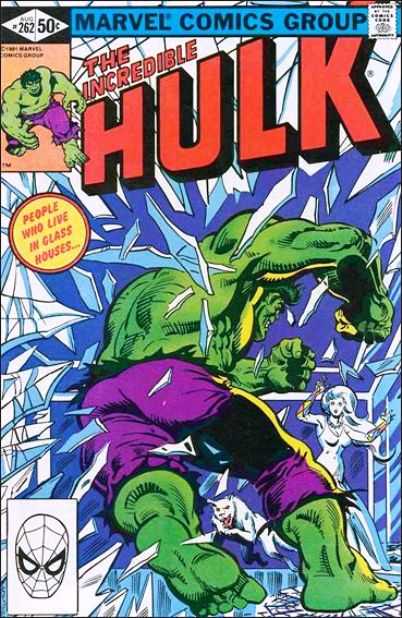
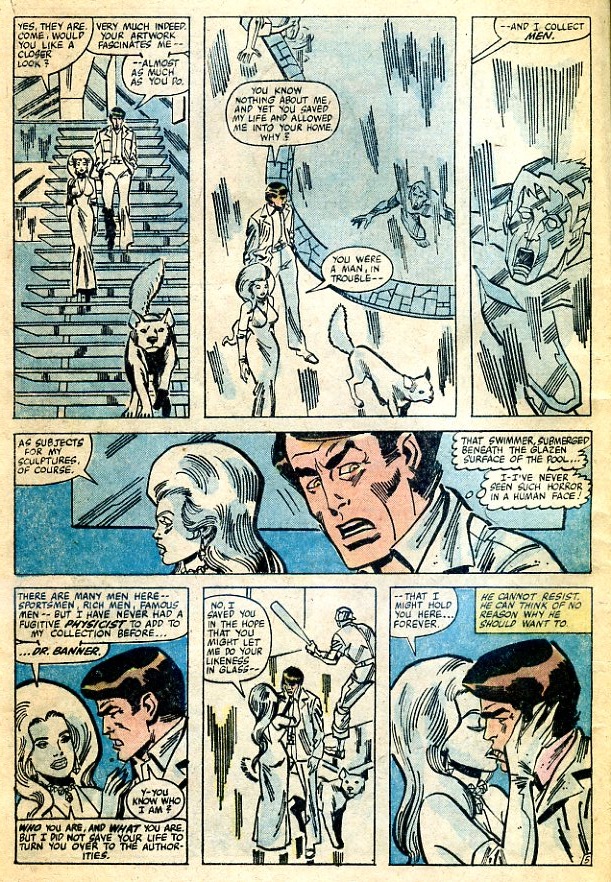
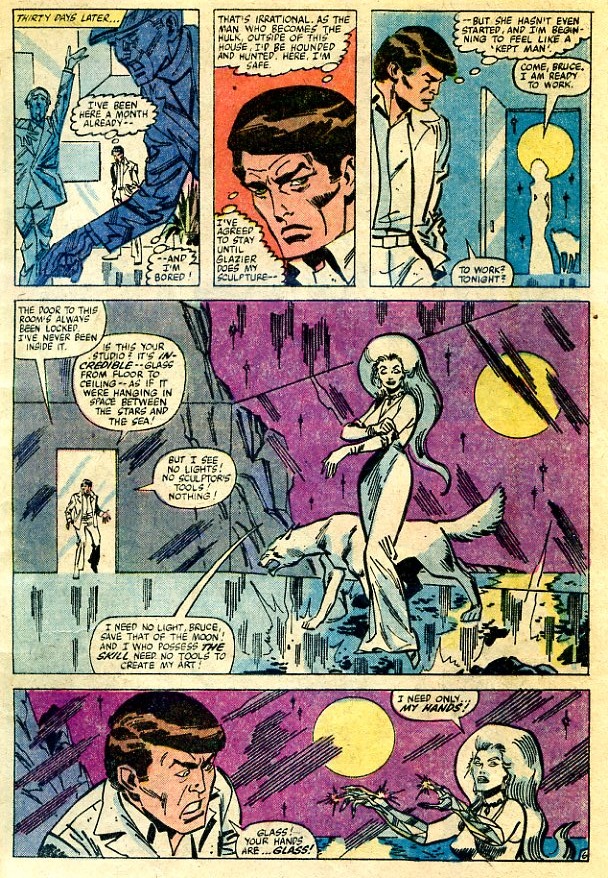
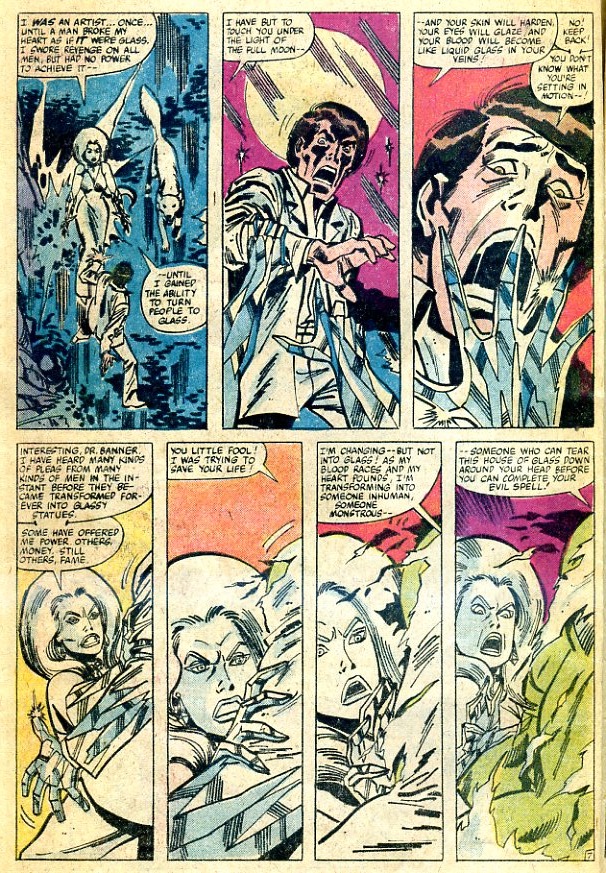
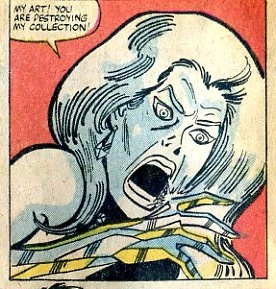
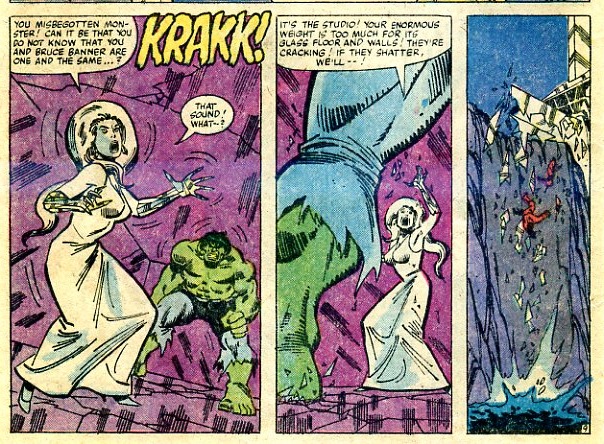
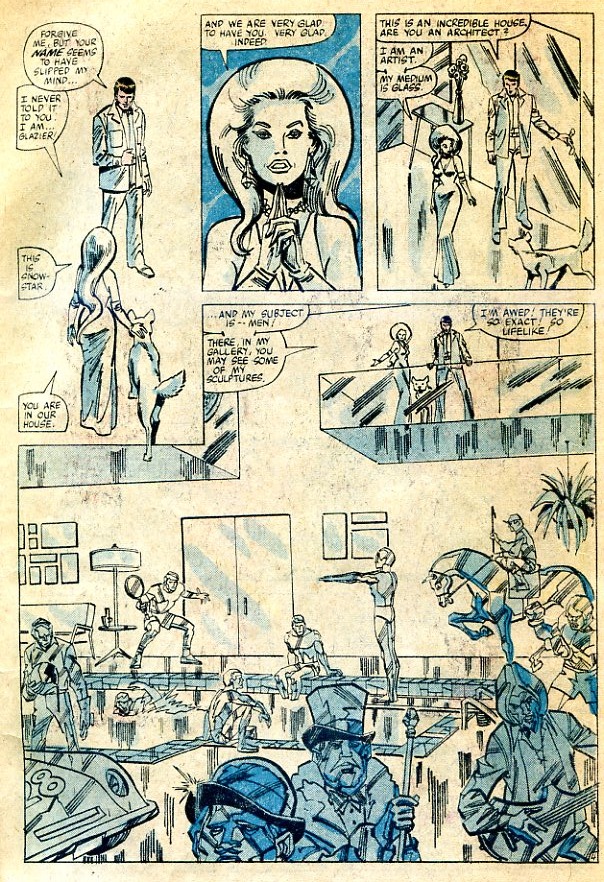
I tend to see the Hulk (clearly, depending on the era, version and who is writing/drawing him) as occupying a liminal space between latency and the onset of adolescence, rather than hypermasculine. Or at least, the version of the Hulk I like best is the one that occupies that site.
I wrote about it on the Middle Spaces late last year: “Snot-Nosed Hulk”- http://themiddlespaces.wordpress.com/2012/12/19/snot-nosed-hulk/
Anyway, I think the idea of “high” or “low” art being feminine or masculine is absurd. If anything, I think of art as queer – as not occupying easily identifiable gender-categories, except positionally. Masculine and feminine are not opposites except in the convenient dichotomies we socially construct.
Well, gender is always socially constructed to some significant degree. Obviously, high art isn’t really feminine, whatever that would mean. The comic works pretty hard to associate it with rapacious femininity, though.
And queerness is often linked to femininization. It certainly has been in the history of art.
I think along the same lines, the Hulk can be adolescent…but come on. He’s a mass of muscles and destructive rage. It’s difficult to deny the extent to which that links up with masculine stereotypes.
Thanks for that link; looks like a fun read.
Huh…just from your essay, the “I want to be left alone” adolescent whininess is also a characteristic male stereotype (“I need to go into my cave now.”)
Thinking about it, its kind of interesting the extent to which adolescent stereotypes and male stereotypes are overlapping and/or influence each other. To such an extent that female adolescence is kind of pushes off to the side as not being ur-adolescence. The Hulk’s maybe an interesting place where you can see that….
Heh…it’s funny, I’ve never liked or been very interested in the Hulk, but you’re piece makes me really dislike him more. Adolescent masculine self-pity as super-powered assault; barf.
I don’t see the “leave me alone” adolescent thing as particularly masculine. As far as I know, no one says that a tween girl who runs to her room and slams the door is “acting like a boy” (though a boy who does it might be accused of acting like a girl or a “baby”).
Queerness’s link to feminization cannot be denied, but the link is positional, that is, only from a perspective that puts masculinity as monolithic, ideal and central.
But yeah, the muscles definitely fit in with the hypermasculine bodies of superhero comics, and the rage CAN be seen that way – but part of what I am arguing is that there is nothing particularly masculine about rage, except that saying it makes it so – I imagine rage to be more existential.
Anyway, like I said – I know that the Hulk has been written to emphasize the masculine wish-fulfillment that is definitely there, but as you know, I like to find alternate readings and seek out versions that challenge the accepted wisdom of these kinds of characters.
Then my essay has had the opposite result from my intent. ;)
No; you wouldn’t say the girl was acting like a boy, but I think in many discussions of adolescence, she just wouldn’t be thought of at all. That is, adolescent rage is just default seen as male. Girls are erased from the equation often, I think.
And I agree that none of this is about “masuclinity is this thing”. It’s just about how it’s positioned in whatever narrative you’re looking at. In this case, I think the female/male positioning of art/comics, sophistication/brutishness, sex/violence is pretty clear.
This is inspiring me to write about She-Hulk – who is probably my favorite Marvel character. Perhaps it is the palette cleanser I need from the piece on Black Lightning and Mat Johnson and Warren Pleece’s Incognegro I have been failing at for a week now.
Well, feel free to run something on She-Hulk (or Black Lighting) here, if you’d like!
I’d say adolescent rage is something addressed and framed as masculine– a girl can also run into her room saying “leave me alone,” but she will usually be typed as being confused, pissed off, irrational, emotional… in effect, her anger doesn’t have a basis in the outside world, and her maturity is marked by self-control. Adolescent males more readily participate in a narrative where they are discovering ‘injustices’ for the first time, and their maturity is marked by making some sort of change to the dynamic. These are horrible generalizations, I know, but feel true to my experience as a teenager.
Osvaldo– Positioning is a key word here. Within the art world, and art discourse, art’s ‘gender’ is a pretty fickle thing. I don’t think this is unique to art. Think of all the complex interplays of masculinity and feminity that go on between two sisters, or two brothers. Within itself, art contains all these dynamics, but it also participates in these dynamics with fields outside itself– like comics. Comics and fine art can be seen as siblings, and they’ve had a long antagonistic (immature) relationship, where they have tried to ‘feminize’ each other in order to get the upper hand. Comics gets help from popular culture, which already tends to feminize high art. Art gets help from popular culture’s readiness to see comics as infantile. Some comics creator tells a story about Lichtenstein crying in the army… etc etc.
Thanks for bringing this comic up, Noah! I had no idea it existed. I would love an anthology of comics that are this transparent– especially in their failure to even depict fine art. I feel like I can squint and see the cartoonist’s own fear of art world appropriation in their disdain for the other ‘victims,’– all the glass men are caricatures of manliness, genres really. I don’t even think the comic can comprehend any ‘evil’ or ‘harm’ in her freezing of them, (do they come back to life at the end?) Hulk gets to be the one impenetrable genre– the superhero– to break the spell, destroy the female consumer, feminized artist… of course in the most brutish way possible.
Hah! That’s a great idea that the others are all masculine genres (is sports a genre?)
Hulk really does come across as impenetrable; it’s not clear why she doesn’t just turn him to glass. The action is presented visually so you can’t really see what’s going on. Theoretically, I think she’s just not supposed to have managed to touch him, but there’s not really any reason she wouldn’t have been able to, so Hulk just ends up being immune by virtue of brutishness/comicness.
Sticking to the mode of generalities, I hear what you are saying Kailyn, but I guess I am looking at adolescent rage against ‘injustices’ not from the perspective of maturity being marked by a change to the dynamic (if I am understanding you) – but rather a change to the self through acquiescence that marks maturity – accepting “how things are.” This is something that is asked of both men and women (though clearly, what women often have to accept is a lot more limited and galling). Yes, men are allowed more outlets for venting rage in acceptable ways without being dismissed as overly-emotional, hormonal, hysterical, etc. .. but there are still limits – limits that while very often marked off by association with the “irrationality” of women also demonstrate the arbitrariness of those gendered distinctions. Part of the very tumult of adolescence is coming to grips with the way gendered distinctions seeking to shape biological change.
As I write in my “Snot-Nosed Hulk” post, what strikes me about the Hulk (or at least a possible Hulk – perhaps not the Hulk in the issue Noah is writing about here) is not his rage, but the *sensitivity* from which that rage often emerges – a sensitivity that I find very touching. So when the Hulk frees puppies in a test lab – Oh, Hulk you care about puppies? What are you, a girl? – I am not seeing his anger as masculine wish fulfillment, lashing out in fear, but a deep empathy that society and its institutions cannot allow for fear upsetting the very distinctions that prop them up.
Regardless, Noah, this was a great piece, and I think your reading of it is right on, even if Bill Mantlo is probably my favorite Bronze Age comic writer.
Good lord. You’re a fan of Bill Mantlo? It never occurred to me that anyone could be a fan of his….
I hope that didn’t come off too snottily…I’m honestly just set aback. But also curious; why do you like him?
Define _too_ snotty. ;)
What he did with ROM alone is reason enough for me. Not to mention Micronauts, and his work on some 1980s Peter Parker, the Spectacular Spider-Man, his creation of Cloak & Dagger. . . . lots of reasons.
When I look back at my favorite stories from my youth he often wrote them, and while they are not without their problems, I still see they’re appeal.
On a personal level, I love that when his Marvel Comics work started drying up he went to law school and became a public defender.
Huh; I haven’t read ROM. Or Micronauts. The writing in this issue of Hulk is dreadful, but maybe he was just not especially engaged…
Bill Mantlo + Sal Buscema is a dream team of Marvel hackdom; all they need is Vince Colletta for the trifecta
Mantlo has a sort of interesting place in the pantheon of comic writers. He was always just unabashedly melodramatic, which in a lot of ways made him the perfect Marvel writer; pretty much everything in the winning Marvel formula was there, by design.
Yet he was generally sneered at by the hard-core superhero fans of the day who tended to prefer the veneer of sophistication that, say Chris Claremont or Frank Miller had. (I mean, if there is any difference at all between Claremont and Mantlo’s prose, it’s only by a degree).
He was panned in a Comics Journal review back in the day, and he wrote a very thin-skinned response, essentially saying “I’m not writing for you, I’m writing for the kids!” And it shows. But I look at it now, and I really kind of like that aspect of it. I think Claremont was really convinced that he was a serious artiste, whereas Mantlo was just sort of free to be a pulp writer, and he dove right in, dialing everything up to eleven. He would throw out some really eccentric idea just casually (kind of like, dare I say, Bob Haney!!!). And he also wasn’t afraid to get really dark on occasion. (The body counts in ROM and Micronauts are pretty high.)
Also, he was basically putting himself through law school writing for Marvel, so it’s not like comics was where he saw himself spending the rest of his life. I think it was all just a fun day job to him.
His career’s sort of coming back into vogue. It seems like I see more and more people recently who grew up on his comics speaking up and mentioning it (often in the context of “Oh, man, there was this messed up comic I read as a kid…” But, hey, that’s something!) I’d rather read him than Claremont, at least.
Huh…well, maybe this was just a duff day for him.
The backup isn’t really all that good, though, I have to say….
I only saw a little of Micronauts, but what I saw was good. Rom was a neat concept inconsistently executed. This issue of Hulk was part of a run I purged most or all of years ago, after I looked at it as an adult and realized that I didn’t like Sal Buscema’s art. I think the storytelling was adequate, which was more important to me then, but it was aesthetically unpleasant.
I think this coincided with the Bixby-Ferrigno Hulk series on television, so Bruce was a vagabond in the comics, as in the show. As an adult, I would think part of the attraction of being a kept man would be a break from sleeping under bridges.
I remember enjoying the frequent changes in setting. It was like an Anthony Bourdain series if he were a transforming fugitive. Marvel used some of the stories to introduce foreign heroes. Others were in fictional lands, like one that had Bruce captive in an underground El Dorado, stuck in mid-transformation. The TV show used the half-transformed gimmick, too, but I don’t know which one was first.
I concur with Chris that much of Mantlo holds up better than much of Claremont. Claremont’s stuff was more sophisticated, but it was also often overwrought and filled with angst. Of course, that was part of the appeal when I was thirteen.
Speaking of Mantlo, after a horrific brain injury in the early 90s, he has been in need of constant care since. . . http://gregpak.com/love-rocket-raccoon-please-consider-donating-to-writer-bill-mantlos-ongoing-care/
When I read the title of this article, I thought you were going to talk about Jeff Koons’ bronze “inflatable” Hulk (with flower wheelbarrow). There’s certainly a bit of literary trickery in that statue.
http://design-milk.com/a-closer-look-at-jeff-koons/
Hah! That’s great. I had never seen that before.
Jones:
“Bill Mantlo + Sal Buscema is a dream team of Marvel hackdom; all they need is Vince Colletta for the trifecta”
The trio did produce a pretty dreadful run of Marvel Team-Up.
I have a soft spot for Mantlo. He’s a socialist, and he often embedded political messages in his scripts.
Mantlo had the unenviable job of following up Steve Gerber on Howard the Duck on the last couple of issues of the color comic and for the entire run of the B&W magazine version. Luckily Gene Colan stayed on, but despite Mantlo’s best efforts and some decent and funny bits, it just wasn’t Howard. Interestingly enough, Gene Colan, if anything, upped his game and those issues looked terrific, particularly the batch inked by Dave Simons (whatever happened to him?).
Mantlo was indeed pretty lefty for much of his career. He did an Attica-inspired story in “Deadly Hands of Kung Fu” early in his career, and did a pretty passionate anti-gun story in Spider-Man. He also wrote the notorious Punisher appearance in Spider-Man where he didn’t bother to disguise his contempt of the character, and used him as a critique of the negative effects of vigilantism (ham-fistedly, as was his wont). This was before the Punisher was the gravy-train he later became, but it was pretty ballsy to basically destroy the character in the way he did.
On the other hand, his Cloak and Dagger series just screamed “mugged liberal” from every page. Maybe because C&D were his own pet characters, their vigilantism was OK, while the Punisher’s was a menace to society? Multitudes!
I believe he did become a public defender after leaving comics. So good on him for doing the work and not making a career out of recycling Death Wish fantasies (which probably would have been more lucrative).
Oh, and Noah: the quality of writing in that issue of Hulk is probably typical of Mantlo. I don’t want to overstate my case for him or suggest that you would like other work of his better. But at this point in my life, I find his overheated pulp more appealing than much of what’s out there now (or then).
Daniel: Dave Simons died a couple of years ago as I recall. Don’t know the circumstances, but I don’t think he’d been working in comics for a while. I liked his work too.
Isn’t this just a really clumsy retelling of the Circe story from the Odessey, except that the dangerous magic women turns men into glass instead of into animals? (The better for Hulk to smash). Is no one bringing up the clumsy appropriation because it’s too obvious to be worth mentioning?
I just didn’t notice it! Good call though.
There are other differences too, though, right? With Circe isn’t it a whole group of them who go there and end up transformed? It’s been a long time since I read any version of that myth….
Odysseus’s crew are transformed before him, and then he frees them! But that’s true in this version too, it’s just that Hulk doesn’t have a crew so the transformed men are strangers. All the fear-of-devious-sexual-women stuff is straight outta the original myth, though. You could talk about how in the Odyssey, Odysseus spends a whole year on the island, while in the Hulk comic, he’s bored after just a month (the modern short attention span). Or about how the bewitching woman is high class with an impeccably decorated apartment.
It fits nicely with the high art/low art divide; classical story crushed by Hulk.
Yeah, clearly if it’d been Bruce and not Odysseus on Circe’s island, he’d have transformed and Hulk-smashed his way out of trouble way before the full year was up :P
But that’s why it’s a bad appropriation of a classic story: as soon as you recognize the set-up, you know exactly how it’s going to play out.
Well…there are lots of reasons it’s bad. But I first read this when I was 10, I think…so I can’t really remember a time when I didn’t know how it was going to play out….
It’s not bad because it’s predictable, it’s bad because it’s like literally the most straightforward version of this story you could possibly tell… but I think Glazier’s interior design sense and fashion sense are pretty cool.